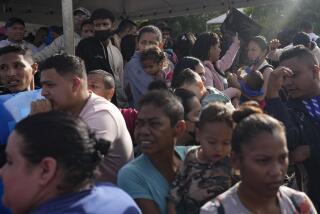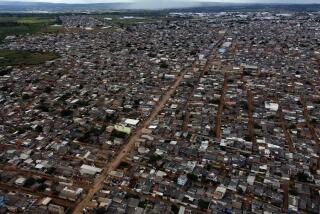Culture : Brazilian, 124, Traces Life to Slavery Era : She was freed in 1888 by her nation, which imported more Africans as slaves than any other.
- Share via
RIO DE JANEIRO — Maria do Carmo, it is said, was born in the same year as French novelist Marcel Proust, American author Stephen Crane and the Russian mystic Rasputin.
The year Do Carmo turned 6, Thomas A. Edison invented the phonograph and Rutherford B. Hayes became the 19th president of the United States.
And in 1888, the year Do Carmo turned 17, Jack the Ripper murdered six women in London, the Kodak box camera was perfected and Brazil became the last country in the Western Hemisphere to abolish slavery.
That was the year Maria got her freedom.
“Yes, I remember that day,” she said recently, a meek smile creeping across her weathered, cocoa-colored face. “Everybody was happy. Everybody.”
Today, the tiny, 124-year-old woman is probably the last living link between the present and the time of slavery, the remnants of which have defined much of the social fabric of Brazil and the United States.
Beginning in the 1540s, Brazil imported more slaves from Africa than any other nation. Of the estimated 9 million Africans brought to the Americas as slaves, historians say that more than 3 1/2 million went to Brazil, where they worked on huge tobacco and sugar cane plantations.
Only about 5%--450,000--went to the United States. The rest were scattered throughout the Caribbean, Central America and numerous South American nations.
Through a fading memory, Do Carmo says she can still recall the horrors of slavery, the rapes, the constant sickness, death, the families torn apart. She remembers the beatings. The whip marks on her back are a constant reminder.
And though her mother died when she was a child, her siblings were sold to another plantation and she barely knew her father, she recites her family tree as if it were a rich legacy.
“I am the daughter of Sabina,” she says. “My father was Jeronimo. I slept in the house with many. I washed clothes in the Serinha”--the plantation where she was a slave until emancipation.
Her complete name is Maria do Carmo Jeronimo, her last name taken from her father’s first name. The middle portion refers to her birthplace, the small town of Carmo de Minas in the state of Minas Gerais just north of Rio. Her birth is registered there in the local Roman Catholic church.
It is the only proof of her age.
According to historians, her father was a “producer,” a slave selected to sire children, a common practice on plantations.
Her mother, who worked in the sugar cane fields, died of illness when Do Carmo was about 8 years old--she is not sure exactly when. She is illiterate. She has no concept of age, money or even countries.
One of her brothers, she recalls, was killed as a child when he was kicked in the head by a horse. Her other brother and a sister were sold to another plantation a few years before her mother died. She never saw them again.
Until emancipation, she lived on a plantation owned by a Brazilian army officer. Do Carmo, who is 4 feet tall and weighs 88 pounds, was limited to housework because of her size. She washed clothes and cleaned the house during the day and in the evenings returned to the slave quarters.
“For plates, we used to carve out pumpkins,” she said of the life of Brazilian slaves. “We ate rice and fuba [a mush of cornmeal, water and salt]. Everybody was always sick. We lived sick. I saw many slaves die.”
Once she caught a glimpse of a man being killed by the slave owner.
“But I didn’t see everything because a woman pushed me away. I was just a child, and they didn’t want me to see.”
At night, she slept in what she described as a dungeon area, which was reserved for the women. The men were housed in separate barracks. Often, she says, the overseer would drink too much, and sometimes he would come and beat them.
“I remember one,” she says. “He was tall. He would come and hit the women. And sometimes he would make them have sex with him.”
After slavery was abolished in Brazil 107 years ago, Do Carmo worked as a nanny in nearby Christina. Decades later, she met Prof. Jose Armelim Bernardo Guimaraes, a historian, there. He had come to the town with his wife and child to visit relatives.
“She was so good with my son, and she was so kind, that I asked her boss whether she could work for me,” said Guimaraes, now 80. “He said that I shouldn’t take her on because she was already old. But she was very strong and a very gentle person.”
That was 54 years ago. In the ensuing years, Do Carmo helped Guimaraes and his wife raise 12 children.
These days, Do Carmo spends most of her time relaxing on the large porch outside the family’s sprawling green brick home in Itajuba in the southern portion of Minas Gerais state.
She works in a little garden planting roses, and at least twice a week she walks 1 1/2 miles to go to church.
Until four years ago, she had never gone to a hospital. She has since gone twice, once for hypoglycemia and the second time for pneumonia.
She says she has three loves: the church, feijoda (a Brazilian soul food) and red wine. She has only two dislikes, marriage and shoes--shoes “because they’re hot” and marriage “because it’s just a problem.” She never wed.
Recently, Do Carmo visited Rio on a special invitation from the mayor so she could see the ocean for the first time in her life.
“It was cold and salty,” she said.
She only has one other wish left, she said.
“Now, I just want to see God.”
More to Read
Sign up for Essential California
The most important California stories and recommendations in your inbox every morning.
You may occasionally receive promotional content from the Los Angeles Times.










